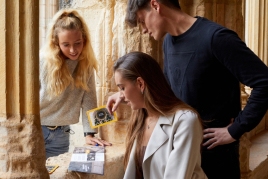Pau Casals route for El Vendrell

The figure of Pau Casals is unique. It is a figure able to lead us to very important moments in the history of Catalonia.
Pau Casals is not simply a cellist. It is the cellist for execel·lència of our lands and possibly the world. But at the same time, Pau Casals is that Catalan musician who made it know to the United Nations while the Catalans gaped of such a feat. And not in vain that his decision has made us present to this day, although he was exiled because of the Civil War.
His presence is kept alive in his homeland in El Vendrell. And the route we offer then invites us to take a tour by bike, or on foot, suitable for all audiences, from the places had walked a thousand times and to enter their most intimate and family life, through the his birthplace and summer.
Viennese?
Pau Casals
 Pau Casals (1876-1973) was the best cellist of all time and one of the best musicians and conductors of his time. He was born in El Vendrell, in a family with great sensitivity to music; father, also a musician, he transmitted the first musical knowledge.
Pau Casals (1876-1973) was the best cellist of all time and one of the best musicians and conductors of his time. He was born in El Vendrell, in a family with great sensitivity to music; father, also a musician, he transmitted the first musical knowledge.
With studios in Barcelona and Madrid, and later also in Brussels and Paris, he perfected his art to reach the highest level. As a performer of cello, Casals brought innovations and new techniques and expressive possibilities, expressiveness also moved to his performances as a director.
The Civil War completely transformed the lives of Pau Casals, which no longer would never go back to his beloved hometown, exiled first in Prada de Conflent (North, France) and then to San Juan de Puerto Rico.
He kept a long musical silence, broken only occasionally charitable, humanitarian or defense of peace. It is famous his speech at the UN headquarters, where he played "Birdsong". The oratorio "The Nativity," which he composed, also became a plea for peace. He died in San Juan of Puerto Rico and his remains rest today in the cemetery of El Vendrell.
Pau Casals is the most illustrious son of the history of El Vendrell. His steps by the population are evident and have led to an interesting and complete path through your life journey.
Route navigation
Pau Casals Route can be done perfectly by bike or foot in El Vendrell. It is an itinerary of 10.39 km with a height of 48 m and 48 m climb down. This is a circular route that passes by the terms of El Vendrell and San Salvador On this route you can see several attractions including:. The birthplace Pau Casals, Pau Casals Auditorium and the Villa Museum Pau Casals.
 This itinerary can not begin elsewhere in the Casa Natal de Pau Casals, which will take place the visit for the life of the Casals family, in the street of Santa Ana, which still retains the atmosphere of a house of a humble family of the late nineteenth century and where you can recreate childhood teacher.
This itinerary can not begin elsewhere in the Casa Natal de Pau Casals, which will take place the visit for the life of the Casals family, in the street of Santa Ana, which still retains the atmosphere of a house of a humble family of the late nineteenth century and where you can recreate childhood teacher.
Once the visit is over, the second stop is inexcusable Pau Casals Museum and we head towards where we have lunch and rest. There you can enjoy the beach of Sant Salvador, the place chosen by Pau Casals to be built, in 1909, the Casals villa seafront where he commissioned his reform architect Antoni Puig, who designed the music room, the charming garden and gazebo on the beach.
He went every summer to rest from touring he undertook worldwide and quietly enjoy with friends and family. Currently, this house, restored to the brightness of the highlights is the Museum Pau Casals.
 Pau Casals Museum has seventeen rooms that trace the life of the great musician, with the support of elements of their private and professional life and the latest technology museum. Audiovisual occur as thread entertaining and deep conductor.
Pau Casals Museum has seventeen rooms that trace the life of the great musician, with the support of elements of their private and professional life and the latest technology museum. Audiovisual occur as thread entertaining and deep conductor.
Finally, you can also choose to visit the modern Auditorio Pau Casals, built in 1981 in front of the villa. This can be an excellent end point of the route, attending one of the concerts that are scheduled during the year, among which the International Music Festival Pau Casals.
Then we return to El Vendrell, where we will finish the route.
Being a path a short distance and low physical demand level it can be considered as an easy route, suitable for the whole family and for all ages.
This route is made up of a handful points of interest mentioned below.
Villa Museum Pau Casals
 The space has a modern museology that respects the original rooms of the house and at the same time shows, in an innovative way, the life and work of Pau Casals.
The space has a modern museology that respects the original rooms of the house and at the same time shows, in an innovative way, the life and work of Pau Casals.
In 1910, Pau Casals Casals Vil·la had built in the waterfront district of Sant Salvador, three kilometers from the town of El Vendrell.
The house, located at the southern end of the beach, was initially conceived as a small summer house that became, over the years and after several interventions in a prominent building with a harmonious garden along which there was a concert hall and a room to exhibit an art collection.
Pau Casals lived until 1939, when he was forced into exile and never returned.
Pau Casals Auditorium
The Auditorium Pau Casals is located in the waterfront district of Sant Salvador, opposite the Pau Casals Museum. It is a modern and agile structure, designed for the basic function to be served, the concert hall. It was opened on June 6 1981.
 The audition room has a capacity for four people. The hall is used for exhibitions and receptions, and equipment has extensive outbuildings that, besides giving possibilities of multiple services, provide great versatility of functions in the Auditorium. It is ruled by the Patronato Municipal Auditorium Pau Casals along with the unquestioned support of the City of El Vendrell.
The audition room has a capacity for four people. The hall is used for exhibitions and receptions, and equipment has extensive outbuildings that, besides giving possibilities of multiple services, provide great versatility of functions in the Auditorium. It is ruled by the Patronato Municipal Auditorium Pau Casals along with the unquestioned support of the City of El Vendrell.
It is a facility serving the music in particular and culture in general. Thus, it can be used to rehearse and record, for training and presentations stays interpreters and recordings.
Music programming is present throughout the year, divided into different cycles, among which there are also jazz and dance. The touchstone of this program is the International Music Festival Pau Casals, which is made since 1981 and has obviously performances of prestigious cellists.
Birthplace of Pau Casals
 The house where Pau Casals was born is located in the street of Santa Ana, 4, in the center of El Vendrell. The building retains the atmosphere of a late nineteenth century from a very humble family. He is a tall, narrow balconies, two storey building.
The house where Pau Casals was born is located in the street of Santa Ana, 4, in the center of El Vendrell. The building retains the atmosphere of a late nineteenth century from a very humble family. He is a tall, narrow balconies, two storey building.
The museum opened on 29 December 1998. On the ground floor you can follow all related childhood musician with the city through photographs and two significant musical instruments that marked the beginning of the career of the Master: pumpkin and gralla. A narrow staircase next to the entrance gate leads to the two - story family occupied the Casals.
Linking travel with genius
 Among the mountainous parts of the Penedès and the sea, extends this narrow flat area, which has served as a communication route since ancient times. In this sense, the roads linking El Vendrell and Sant Salvador beach?? were used by trucks carrying wine, as this beach became one of the main export ports and liquors. For this reason, often Pau Casals made this journey on a mule and / or truck that performed this journey transporting wine to the coast. At other times, this tour he did with his mother to go see the sea, and the chapel of San Salvador. This chapel is Romanesque and is dated from the eleventh century, although the cover is 1900.
Among the mountainous parts of the Penedès and the sea, extends this narrow flat area, which has served as a communication route since ancient times. In this sense, the roads linking El Vendrell and Sant Salvador beach?? were used by trucks carrying wine, as this beach became one of the main export ports and liquors. For this reason, often Pau Casals made this journey on a mule and / or truck that performed this journey transporting wine to the coast. At other times, this tour he did with his mother to go see the sea, and the chapel of San Salvador. This chapel is Romanesque and is dated from the eleventh century, although the cover is 1900.
What to do
Museu Apel·les Fenosa
El VendrellVisit the Apel·les Fenosa Museum and discover the legend of a 16th…
Aqualeón Water Park
Albinyana (a 4.1 Km)Aqualeon Water Park, which covers an area of 80,000 square meters, has…
Centre d'interpretació de l'aviació republicana i guerra aèria
Santa Margarida i els Monjos (a 14.4 Km)The CIARGA (Interpretation Center for Republican Aviation and the Air War) is…
Hotel Balneari Platja de Comarruga
El Vendrell (a 4.7 Km)Spectacular resort located near the sea to enjoy the marine environment and…
Where to eat
Bodega Miquel Jané
Font-rubí (a 24.3 Km)Discover the world of wine with our comprehensive viticulture and oenology courses,…
Where to sleep
Hotel Balneari Platja de Comarruga
El Vendrell (a 4.7 Km)Spectacular resort located near the sea to enjoy the marine environment and…
Càmping Stel
Roda de Berà (a 8.4 Km)Camping bungalow on the beach of the Costa Daurada, with modern facilities…
Camping Capfun Alba
Creixell (a 10.5 Km)Located on the Costa Daurada, 150m from the beaches, the Capfun Alba…
Càmping Arc de Barà
Roda de Berà (a 8.2 Km)Arc de Barà is a very family-friendly campsite 60 meters from the…















